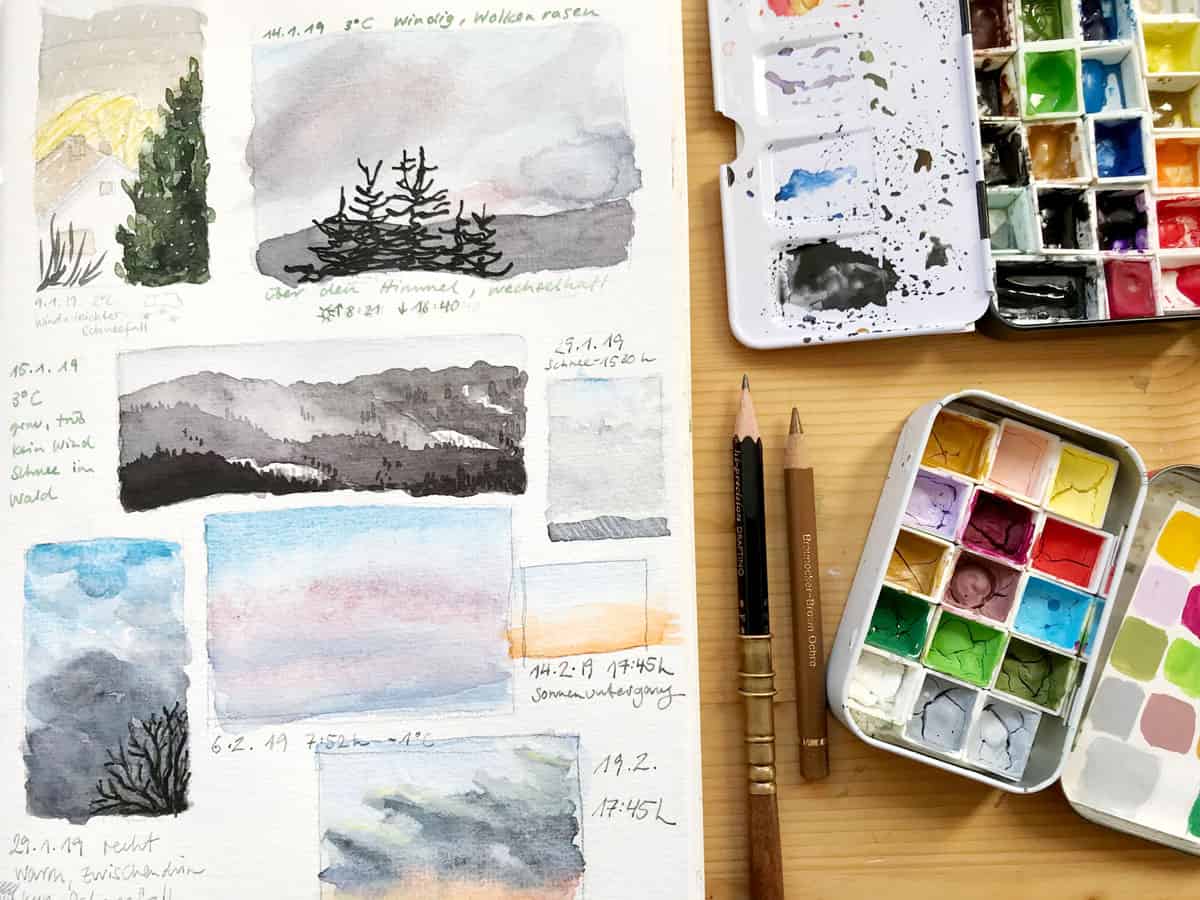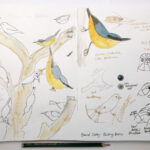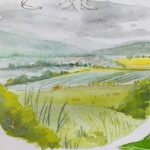In order to develop a creative habit, you will have to overcome a few obstacles. The good news is that this isn’t actually so hard to do when you have a plan. This plan will work for all kinds of creative goals, no matter if you’re a professional or just looking to build a new hobby.
The first thing you need is of course some activity you like or want to learn. This might sound surprising, but I’ve heard from so many people they’d like to be more creative, and then didn’t have any specific technique in mind. If you’re not sure what, just pick anything. You can always adjust the course later when you find out what you like better. Maybe you want to learn sketching. But it could as well be writing, photography, gardening, welding, or lettering.
The next and most important step (you’ll have to repeat this one over and over again) is to get out of your comfort zone. This means facing the challenge of not feeling it, or self-doubt, or a noisy environment, and showing up anyway. There will always be something in your way (I know because I face the same challenge every morning). The good news is: you can build systems to make this process easier.
Usually, at the beginning of exploring something new, you will feel invigorated and motivated. In the beginning, building your creative will not require much work, because you want to learn everything about this new topic. But after a while routine can set in. You will actually need routine (I’ll talk about it in a second), but the mundane feeling that comes with routine also makes it harder to stick with a habit. If you really want to learn something, you’ll have to overcome this feeling and show up. If you want to be a professional, you’ll definitely have to show up. Do it even though you don’t feel like it. If you just pursue something in your free time, it can still be worth to overcome the feeling of being stuck. If you find out after a short while of pushing yourself that this thing is not really for you, even better. You can cross it from your list, and you have at least explored it thoroughly.
You know, creativity is a funny thing. It always sounds so lofty, like you only need that divine touch of talent and then everything will just flow from your fingertips. It never happens that way, usually creativity is the result of hard work and routine. And it can really be quite hard. I know there are a lot of writers who don’t actually love the process of writing, but only the feeling of having written. They have to force themselves to their desk every day. And if you’re looking to build a career in whatever creative field, it can take years to get traction and success. So you have to factor in a lot of showing up over the years, even when you don’t want to or feel frustrated. And even when exploring a creative skill in your free-time, you can hit phases where you just don’t feel like it or you hit a wall. Continue anyway.
Hopefully, you’re still motivated at this moment. There are a few strategies you can implement that will make building your creative habits easier. These are all methods that I’ve implemented in my creative routine in the past.
The most important thing is consistency. Practice what you want to learn over and over. This is the only way to get better. You need to learn the basic tools of your trade, and you can only learn them through repetition and consistent learning. Create a routine.
If you’ve already built on your creative habits for a while, consider taking it a step further. Don’t just practice, but practice the things you’re not good at. This kind of deliberate practice makes sure you will not stagnate.
One of the best ways to establish a regular practice is making a simple plan with short, practical steps, and plan ahead for what you want to do the next day. Want to write? Put your notebook and pen on your desk (or open your writing app the day before). Want to sketch? Put your pens and brushes near your sketchbook so you can start immediately. Want to cook a new meal? Organize your kitchen so you can start, and have the ingredients ready.
Schedule your creative time in advance, and, if you can, try to keep it in the same time slot. It can also help to have a dedicated space for your creative activity, so you won’t have to collect what you need every time.
Another thing that’s really helpful is to create accountability. Tell others about your plans, this will help you to go through with it. Why? We all want to be socially accepted, and accountability actually puts light social pressure on us to keep up our claim. You can create accountability partnerships with family members, friends, or online.
One of the most important strategies is to avoid distractions. Go somewhere quiet or put on headphones. Turn off your phone. Start with a tidy desk. Make sure you won’t be interrupted. Turn off your internet connection or go somewhere without internet. Get up at 5am. I’ve done all of these things in the past to ensure I can create in peace, and work without distractions.
Again, remove any obstacles that you might still feel. This is about you and your feelings. Don’t feel good enough? Are you afraid of making mistakes or not living up to your potential? Well, if you don’t do anything, you’ll never reach anything near your potential. Embrace the possibility that you mess up. It’s actually a part of the process through which you learn.
Lower your standards, and start anyway. Don’t feel like you have to deliver perfect work, just create something. Often, once you’ve actually started, these voices will fade as you immerse yourself into your work. So getting started is the most important thing. You can always edit what you created later, or start over with the knowledge of what you want to change. Mistakes and imperfection are actually the best path to creativity, as you learn from them and can give yourself the chance to choose the elements you want to include in your work in the future. Don’t view it as something static, but as a process. Allow yourself to create imperfect things.
I’ve been using these strategies in the past several years to constantly push myself to put out creative work every day. Most of the time, it works. On other days, it’s hard. But I always try to stick with them.
How do your approach your creative activities? Have you built certain habits around it? How do you approach mistakes? I’d love to hear your perspective. Let’s discuss!






I enjoy various types of art so I have several different journals…a bullet journal for my monthly schedule, an experimental journal to explore different techniques, a gesture journal for working on various quick gestures to hopefully improve my observation skills as well as drawing skills, a book for drawing still life and daily items (pencil sharpeners, potato peelers, flowers, keys etc), a copying book where I try to copy someone’s work to figure out how they did it and why I like it (colors, shapes, shadows, subject matter, brush strokes etc) to help me develop my style by learning from them, zentangle/doodle book, a personal journal to express my feelings through art, a quote book to enter my favorite quotes along with a drawing or fancy lettering. It gives me plenty of options so I can always find something I want to work on whether it is for 5 min or 5 hours. I find it is the chance to chose an option depending on my daily mood that keeps me motivated to do art each day.
I’ve been thinking about doing something similar but was undecided, so it’s been really helpful to me to read about your various journals. Thanks for sharing!
I love this idea of separate journals. I’ve been putting everything in one daily journal and this sounds much more organized and accessible for future reference. Thanks for sharing. And thank you, Julia, for a very helpful post!
I love this approach Lin, thank you so much for sharing it!
Hi, Julia. I began water colour painting about three years ago to try to move myself up from the pit of depression. An acquaintance suggested I join a group of painters that meet for 2 1/2 hours twice a week. The group ranges in age from about 40 to almost 90. There is no formal instruction but we help each other. Through this group I have gained confidence to go to a two week retreat each summer with a professional artist and many accomplished painters; exhibit my work at a local gallery; and join our city’s art association. My depression is under control and I enjoy the creativity and sense of comradery I have with other artists. Belonging to this group achieves many of the goals you have laid out: be consistent in scheduling creative time; involve others so there is accountability (we miss you, where have you been?); no distractions. We pay only $3 per session for room costs. We meet at a church but it could be an apartment building common room or other club room. No membership fees or meetings, just a group of like-minded women.
Susan, thank you for sharing your story, what a wonderful healing journey. I’ve made similar positive experiences with art groups like this. I hope your group will continue to meet for a long time!
I try to lower my standards and if I do make a mistake, I try to work it into the design or cover it up with another medium. For example, a mistake in a watercolor piece that can’t be removed, I’ll use colored pencils and add more elements to the design for a mixed media piece. For those days I don’t know what to create, I’ll just work with abstract shapes or do watercolor washes and try different techniques with it.
That’s a great approach, Diane, and I think it shows that you don’t have to view mistakes as the end of the world, but instead as a chance to explore a different route for you piece.
For a long time I was someone who started new things but soon packed in as I reached a certain level and then didn’t seem to improve. I just didn’t have the determination to persevere. In the last year though I have got much better and I can point to 2 things that have really helped. The first was the book ‘The Sorites Principle – how to harness the power of perseverance’ by Ian Gibbs. It made me realise that by just doing a little bit every day you eventually get better and better. He has lots of strategies to help you stick with things. It’s a very readable and non preachy book. He taught himself Catalan in 6 months to a level where he gave a presentation to a business group.
The strategy that works best for me is to build a run of consecutive days of doing something. Once I start I don’t want to break the chain. I found an app called ‘Streaks’ and each day you record that you have completed the task and it shows how many consecutive days you have done. (It doesn’t have to be daily, it could be a number of times in a week). I used this approach when I started sketching and went for 300 consecutive days, though I have now scaled it back to 3 days a week. I always said I was someone who said he couldn’t draw, to realising that with purposeful practice I actually could.
Looking at the app I can see that I have also done 59 consecutive days of meditation, 88 of journaling, and 79 days of walking or running at least 10,000 steps. There are also things I have not done. 65 days of not eating chocolate bars and not drinking sugary drinks.
For many days the improvements are not even noticeable but it’s the cumulative effect of doing things day after day that stack up. All the walking and running as well as eating more healthily, has meant that in less than 3 months I have lost 9kg of weight, my resting heart rate is classed as excellent and at 58 I am running faster than I was 10 years ago.
I know without doubt that without these strategies and not having goals to aim for, I wouldn’t have persevered and reached the levels I have. I now believe that if I really want to achieve something I can do it if I persevere.
Wow, what a story – congrats on all of these great changes, Steve! And thank you for the book recommendation, I’ve taken a note to check it out. That sounds like a sound strategy – I’ve made similar experiences with building habits. If you stick to it and keep practicing, you will get better and can make very measurable steps towards a goal. Great that you were able to make so many positive changes and that you experienced what you’re capable of if you really try.
Hi Julia,
Another great post. I really enjoy how you think.
Thanks for sharing it in clear logical thoughts.
Creating a schedule is great advice.
Personally, I find it to helpful to have each day of the week allocated to the type of content I’ll produce, then deadlines for content each month.
Then I never have to think about what I should be working on that day and it removes 365 choices from my life each year.
For example:
Monday & Tuesday are for writing or editing, with the early morning being for photo editing. (3 X 2 hour deep work sprints )
Wednesday & Thursday are for creating video and editing it, with the early morning being for photo editing.
Friday is a “wildcard day” meaning determine what’s the most important to accomplish & do it.
Saturday is cheat day, meaning do / eat / drink whatever you want BUT No computer, no work, no screens.
Sunday is planning for the next week using the Getting Things Done Method.
I love reading about how other people get their work done.
Thanks again for sharing.
Dave
Hi Dave, thanks! What you write makes a lot of sense and I love the idea of spending one day a week with anything you want, and no screens. I will try that and see if it works for me.
I’m not always that dedicated to my schedule, but like you I love to have the start of the day for my most important work. If there’s one rule I try to stick to, then it’s this.
I also love to hear how other artists organize their day, especially since creative routines can differ so much. It’s funny, my days were a lot easier when I still did photography – once I was outside with the camera it all seemed to keep going on its own. The home studio days with access to the internet are definitely more challenging.
Thank you for sharing your daily routine, really insightful!
Julia